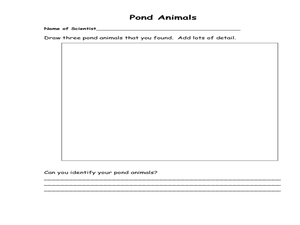Curated OER
Genetics: Mice Rule! (Or Not)
Pupils explore genetics and evolution by examining a hypothetical mouse population. Using coin tosses, they determine mouse traits of parents and offspring. Finally, they consider the outcomes of changing environmental conditions on...
Curated OER
Mutations--Preexisting or Acquired?
Students explore the reasoning and experimental approaches to mutations. They expose a culture of E. coli to virulent bacteriophage and observe whether mutations of the cells existed previously or if the bacteria mutated as a response...
Curated OER
Bird airport control
Learners identify the various species of birds found in the wetlands. Students observe and record the key skills involved in scientific inquiry. Learners handle and interpret data gathered on a field trip which reveals patterns and...
Curated OER
The Excretory System
In this excretory system worksheet, students read a brief excerpt about water balance and the excretory system. Then they identify what compound birds, insects and reptiles living in dry habitats excrete. Students also describe how...
Curated OER
How Do Environments Change?
For this environments worksheet, students will write in the effects fire, dams, and people can have on the environment. Students will complete 4 fill in the blank statements.
Curated OER
Pollen & Pollination
Students identify the different ways things are pollinated and how to manage pollen. In this pollination lesson students complete an experiment on how moths pollinate flowers.
Curated OER
Adopt-An-Insect II
In this biology activity, students adopt an insect of their choice and draw a diagram of their insect, labeling the major body parts. Then they describe where their insect can be found and what they eat.
Curated OER
Animal Species Richness in Tioga County, PA
Pupils compile an extensive list of animal species seen throughout Tioga County. In this data collecting lesson, students report daily any animal species seen during the course of their travels and adventures outdoors in Tioga County for...
Curated OER
Pond and Pond Organisms
Students explore pond ecosystems. In this pond organism activity, students will use pond water and a plastic bad in order to locate and identify freshwater organisms. The activity is designed for younger grades, but...
Curated OER
Scavenger Hunt: Simulating Natural Selection
Students simulate natural selection using pinto beans. In this biology lesson, students identify the factors affecting organism evolution. They record data from the experiment and formulate a conclusion.
Curated OER
Adaptive Backpack Checklist
In this backpack checklist worksheet, students check off 4 items to have in their backpack: pencil, folder, notebook and lunch bag. A website reference for additional resources is given.
Curated OER
Adaptive Worksheet-Personal Information
In this personal information worksheet, students fill out a form with basic personal information. A website reference for additional resources is given.
Curated OER
Physical Adaptations in Ice Age Mammals
Students identify the body parts in Ice Age mammals that allowed them to survive. They answer questions as a class and discuss. They examine photographs of the animals as well.
Curated OER
Learning From Leaves: Adaptations To Differing Light Levels
Students, in groups, examine plants with different light levels. They are given plants from a tropical and desert region. They write a hypothesis at the beginning of the experiment.
Curated OER
Diversity And Adaptations Of Organisms
Seventh graders investigate how organisms respond to environmental stimuli through their behavior. They observe how plants and animals respond to varying amounts of light, water and gravity.
Curated OER
An Adaptable Four-Skill ESL Information-gap Acivity
Students encounter a variety of grammar structures and vocabularies in the English language. Students get involved with teacher statistics as well with this lesson. Students correlate facts thru chronological order steps. Students...
Curated OER
Interdependence and adaptation
Students use keys to identify animals and plants in local habitats. Students are asked if they remember what the word habitat means. Students make a list of three different local habitats and brainstorm animals and plants they might...
Curated OER
Roots, Stems, and Leaves
In this plant worksheet, students review the structure and function of roots, stems, and leaves. This worksheet has 5 matching, 7 true or false, 4 multiple choice, and 10 fill in the blank questions.
Curated OER
Cinderella: an Adaptation
Students create a list of characteristics for the heroine of a fairy tale and discuss ways these images affect behavior and self-esteem. In this, The House on Mango Street gender equity lesson, students identify common...
Curated OER
An Adaptation of Microbe Hunters
Students dramatize a two act play in which scene one depicts the story of Lazzaro Spallanzani and the second act deal with Louis Pasteur and his refutation of spontaneous generation.
Curated OER
Animal Movements
Students discuss the behavior of different animals and how they move. They explore the ways that this helps them live and find food in their environment. They participate in a game that requires them to mimic the ways in which animals move.
Curated OER
How Are the Eyes of Different Organisms Adapted for Sight?
High schoolers compare/contrast the human eye to two other organisms. They use micro viewers to identify the human eye structures, complete a Venn diagram worksheet, identify the function of each eye structure, and answer discussion...
Curated OER
Science: Identifying Fish Parts
Young scholars identify parts of fish and their functions. They compare the fish's body parts and purposes to their own. Working in groups, they complete worksheets by labeling fish parts on a drawing.
Curated OER
Science: Observing Fish Behavior
Fifth graders, working in pairs, select and observe fish in the Aquademics aguarium. They record their observations on worksheets and make graphs displaying the frequency of various fish behaviors. Students then discuss their...
Other popular searches
- Animal Adaptations
- Ocean Animal Adaptations
- Bird Beak Adaptation
- Plant Adaptations
- Behavioral Adaptations
- Adaptation and Evolution
- Bird Adaptations
- Insect Adaptations
- Plant and Animal Adaptation
- Fantasy Animal Adaptations
- Fish Adaptations
- Adaptation Habitat























